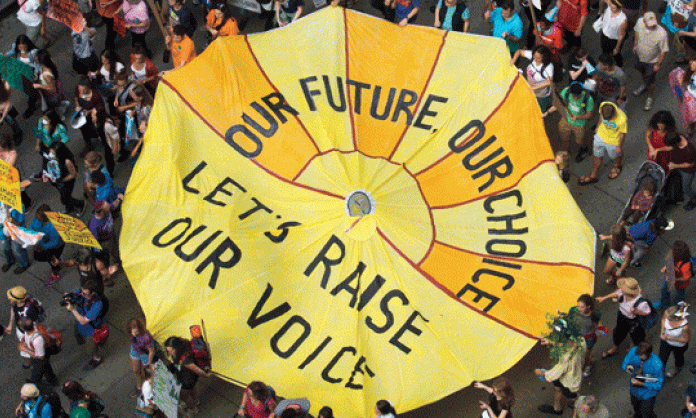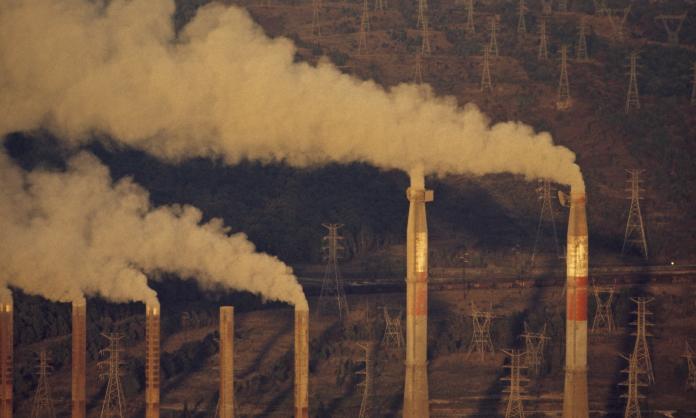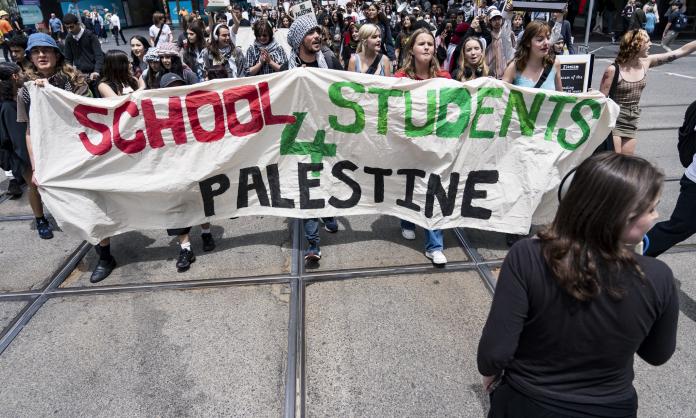The largest demonstration to date on the need to stop global warming was held in New York City on 21 September.
The historic event brought together a wide range of groups and individuals in a march through Manhattan, two days before a meeting of heads of state and government gathered at the United Nations to address the issue.
The marchers were not on the streets to hail the UN meeting, but to raise the alarm. This was made clear when the vast throng stopped for a moment of silence in honour of those who have already died around the world as a result of catastrophes linked to global warming.
Then the entire crowd erupted in a tremendous roar to literally sound the alarm. Twenty-six marching bands blared their instruments. All kinds of groups brought their own noisemakers. But the main outcry was from the throats of the hundreds of thousands of ordinary people there to make their opinions known.
All kinds of groups were present, including indigenous peoples from the US, Canada and Latin America, who have borne the brunt of ravages inflicted by the big energy companies, from the tar sands of Canada to the forests of Ecuador ruined by Texaco.
A participant told me that the number of young people present was striking.
More than 75 labour unions endorsed the march, and some had important contingents. These included the Service Employees, Nurses, Transit Workers, Communication Workers and Teamsters. There were significant numbers of African Americans and Latinos in these contingents.
A leader of health care workers in the Service Employees explained that many of its members are nurses from the Philippines, hard hit by ever bigger hurricanes.
The participation of these unions represented an advance in involving labour. Many other union leaders fall for the capitalist argument that fighting climate change will hurt jobs.
Students from many universities and colleges raised the issue of their struggle to get their institutions to divest from fossil fuel.
This truly was a grassroots march, not a top-down affair. Organisers encouraged everyone to bring their own banners and literature and to raise their own concerns.
The result was that the varied aspects of the problem of climate change were expressed.
As momentum built for the march, it inspired similar marches and rallies to be held around the world that day. One estimate is that more than 2,000 occurred in 162 other countries.
It also resulted in solidarity actions being held in cities around the US, including in the San Francisco Bay Area, which I was part of.
The activist wing of the environmental groups, including 350.org (named for the goal of reducing carbon dioxide in the atmosphere to 350 parts per million), initiated the action. But as momentum for the march rose, even the more conservative groups like the Sierra Club endorsed it.
Another group that initiated the march and was instrumental in helping organise it was System Change Not Climate Change (SCNCC).
This group is a coalition of socialist organisations and individual socialists who argue that the capitalist system is the cause of climate change and advocate socialism as the only long term solution. SCNCC formed its own contingent in the New York march.
The role played by SCNCC and other socialist groups in the march, and their acceptance as part of the broader environmental movement, marks a step forward. SCNCC together with others held workshops and plenary meetings on the Friday and Saturday preceding the march, attended by some 2,500.
A major reason for the ability of socialists to lead in this way is the impact of the Great Recession and the subsequent stagnation, which have hit working people hard.
Also, every single target of the environmental movement – from the XL pipeline, tar sands oil, mountain top removal, big oil and gas, fracking, to pollution of rivers, etc. etc. – is a capitalist corporation. It doesn’t take a big leap to generalise from these separate targets to the capitalist system.
The day after the big march in New York, more than 1,000 people held a sit-in near Wall Street, which was explicitly anti-capitalist. Some 100 were arrested after eight hours. Their action was called “Flood Wall Street” – a reference to the actual flooding of the area during Hurricane Sandy.
In the Bay Area, it was a small chapter of SCNCC that initiated the proposal for a solidarity action to coincide with the New York march.
At first it looked like any action would be small. But as the momentum for the New York march grew, it mushroomed to more than 100 endorsers. As in the New York action, there was a grassroots enthusiasm that resulted in many colourful and ingenious manifestations. The rally, held in Oakland, drew 4,000.
The anticlimax was the UN meeting two days after the march. As the 400,000 expected, nothing came of this meeting except a lot of hot air.










